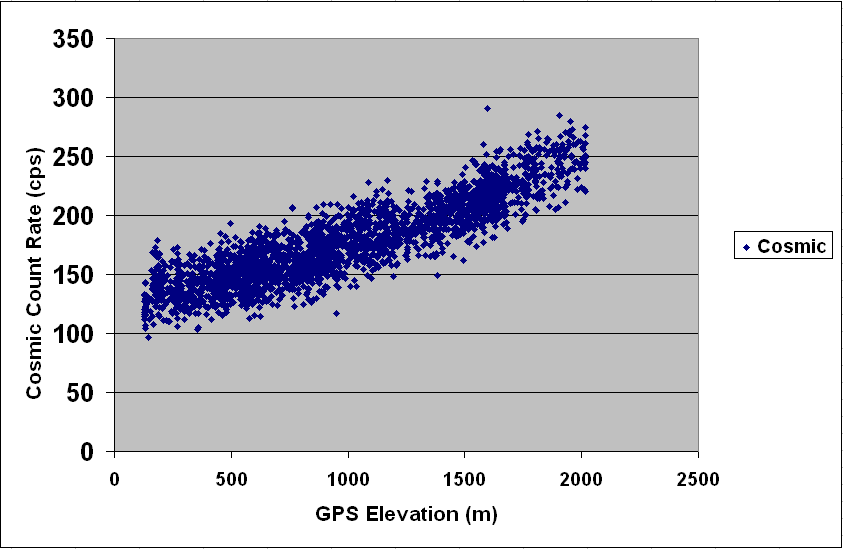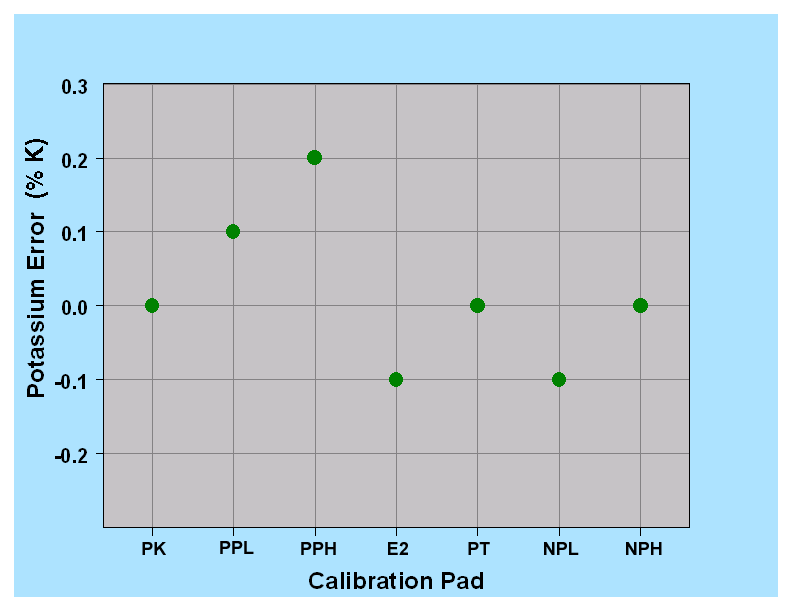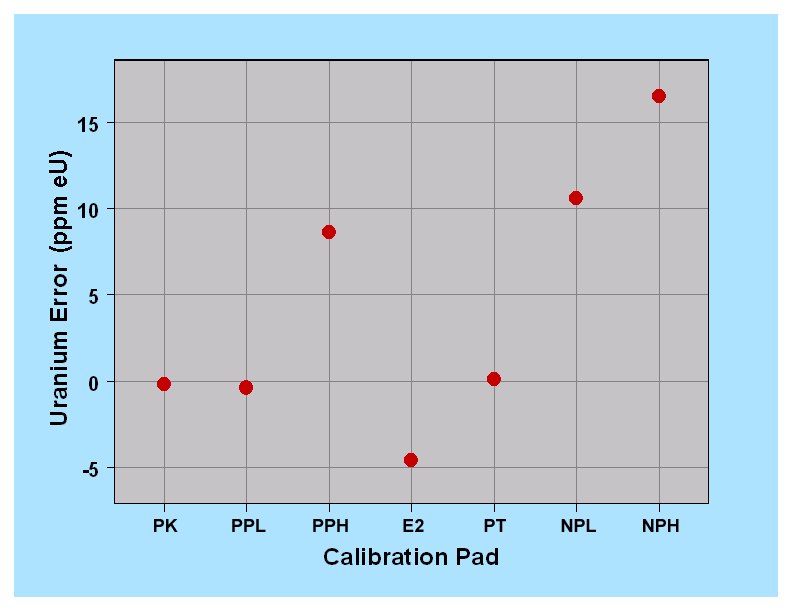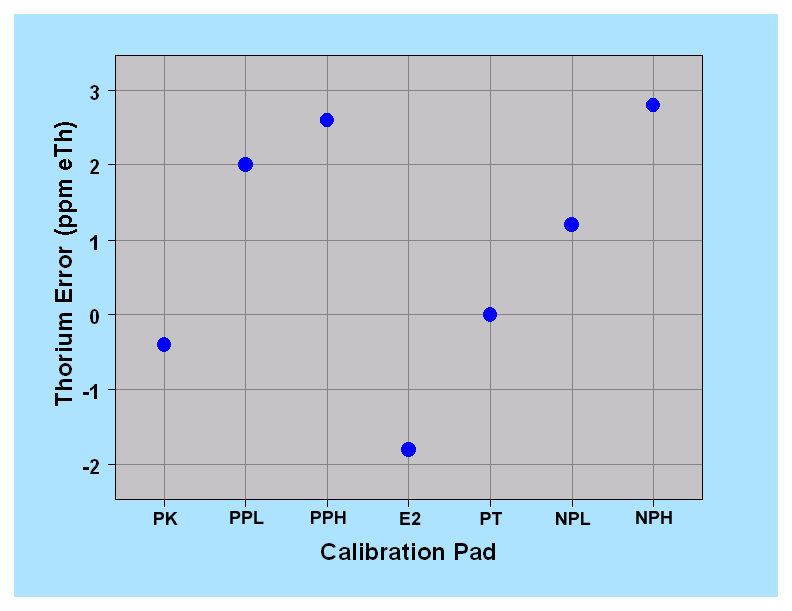
The procedures described here represent one way to use the calibration pads to calibrate a gamma-ray spectrometer but other approaches could be used. These procedures have been used by the U.S. Geological Survey and result in reasonable calibration equations. Typically the detector is placed in the center of each calibration pad (note that the covering lid should be removed first) and a series of measurements made. The USGS preferred method is to obtain multiple measurements on each pad. For field gamma-ray spectrometers similar to those used by the USGS (e.g. Scintrex GS512 with a 3" x 3" detector), the measurement time is typically 5 minutes. USGS experience has shown that a 5 minute measurement time gives good results for typical soils and rocks. The time interval used for calibration should be the same as that to be used for normal operations. A different time could be used but doing that requires adjusting the calibration constants for other time intervals and is a likely source of error.
After all of the measurements are completed, the data for pad PB should be averaged to obtained "background" estimates for the spectral windows used to measure the potassium, uranium, and thorium gamma rays. International Atomic Energy Agency (1991) recommends the energy windows shown in table 4. This estimate of "background" includes cosmic radiation and gamma-rays from the soil and other materials near the calibration pads but does not include possible interference effects from adjacent pads. The background count rates should be subtracted from the count rates measured for the other calibration pads. The corrected count rates are then used with the assigned pad concentrations to calculate calibration constants. A linear least squares regression algorithm is typically used for these calculations. The USGS does not endorse any particular software for linear regression calculations and a number of commercial software packages are available. Packages that the USGS has used successfully are PsiPlot from Poly Software International and Axum from Mathsoft Incorporated. The equations to be used are:
K = a11 Rk + a12 Ru + a13 Rth
eU = a21 Rk + a22 Ru + a23 Rth
eTh = a31 Rk + a32 Ru + a33 Rth
where K, eU, and eTh are the known concentrations of the pads, Rk, Ru, and Rth are the background-corrected count rates, and a11, a12, a13, a21, a22, a23, a31, a32, and a33 are the calibration constants that result from the linear regression calculations. Using the parlance of linear regression calculations and potassium calibration as an example, the potassium concentration (K) is the dependent variable. The potassium concentrations of the various pads are used to define a column matrix. The measured count rates (corrected for background) are the independent variables and are used to define a matrix of three columns. The calibration constants represent the unknown linear regression constants. The definition of the matrices is dependent upon the software package used and is beyond the scope of this discussion.
One source of error that results from using the derived calibration equations is the fact that the background measured at the calibration site will not be correct for some other location. This is more significant for locations at higher elevations where the cosmic radiation is greater. In principle, background estimates can be obtained by making measurements in a clean fiberglass or aluminum boat on a large body of water at least 200 m from any land. Using the calibration constants given in table 6 and the average count rates measured for the background pad (PB) the calculated concentrations are 0.3 %K, 0.9 ppm eU, and 1.5 ppm eTh. This result emphasizes the need to make background corrections. Figure 6 is a plot of cosmic count rates versus aircraft elevation from an airborne gamma-ray spectrometer. The measured cosmic count rate at 2,000 m is about twice that at sea level. This measured increase is consistent with equations for estimating cosmic dose at different elevations (Boltneva, Nazarov, and Fridman, 1974). If the background count rates cannot be measured, such equations could be used to estimate the changes due to elevation differences.
Another potential source of error for the uranium concentrations is the fact that the radon emanation from the pads may vary significantly from that of a measurement site on soil or rock. The calibration procedure generally used by the USGS assumes that the radon emanation from the pads is the same for all of the pads and that soils and rocks will have similar emanation rates. The emanation fractions estimated from measurements on samples from the pads (refer to table 2) suggests that the assumption of equal emanation from the pads is reasonable. However, measurements made on the pads indicate that pads NPH and NPL have higher emanation rates than those estimated for the samples. Table 5 lists average count rates and calculated pad concentrations for a field gamma-ray spectrometer and table 6 lists the matrix of calibration constants calculated using only pads PK, PPL, PPH, E2, and PT. Figures 7, 8, and 9 show the errors in the calculated pad concentrations for potassium, uranium, and thorium, respectively.
Table 4. Gamma-ray energy windows recommended by International Atomic Energy Agency (1991) for surveys of potassium, uranium, and thorium concentrations in soils and rocks.
|
Window |
Source Isotope |
Energy Range (MeV) |
|
Total Count |
- |
0.4 - 2.81 |
|
Potassium |
40K (1.460 MeV) |
1.37 - 1.57 |
|
Uranium |
214Bi (1.765 MeV) |
1.66 - 1.86 |
|
Thorium |
208Tl (2.614 MeV) |
2.41 - 2.81 |
Table 5. Average count rates and calculated pad concentrations for a field gamma-ray spectrometer with a 3" x 3" detector. Ck, Cu, and Cth are the count rates for the potassium, uranium, and thorium energy windows after background correction. K, eU, and eTh are the pad concentrations calculated using the constants in table 6. The average background count rates measured for pad PB are 754, 290, and 166 for Ck, Cu, and Cth, respectively.
|
Pad |
Ck |
Cu |
Cth |
K |
eU |
eTh |
|
PK |
16289 |
529 |
72 |
6.3 |
3.0 |
1.0 |
|
PPL |
11101 |
9056 |
760 |
1.2 |
41 |
3.4 |
|
PPH |
25818 |
25872 |
1532 |
1.1 |
118 |
3.3 |
|
E2 |
47454 |
48427 |
3198 |
1.7 |
221 |
9.3 |
|
PT |
24374 |
19746 |
28787 |
1.7 |
13 |
271 |
|
NPL |
9548 |
6817 |
728 |
1.4 |
30 |
4.1 |
|
NPH |
24108 |
23324 |
1452 |
1.3 |
107 |
3.7 |
Table 6. Matrix of constants used to calculate potassium, uranium, and thorium concentrations determined using data obtained on the calibration pads.
|
Element |
Ck factor |
Cu factor |
Cth factor |
|
K |
0.0004 |
-0.000354 |
-0.0000367 |
|
eU |
0.0000427 |
0.0047 |
-0.00281 |
|
eTh |
0.0000319 |
-0.00048 |
0.00972 |

Figure 6. Graph of the cosmic count rate as measured by an airborne gamma-ray spectrometer versus the elevation of the aircraft determined by a global positioning system (GPS).

Figure 7. Errors in the calculated concentrations of potassium relative to the assigned values.

Figure 8. Errors in the calculated concentrations of uranium relative to the assigned values.

Figure 9. Errors in the calculated concentrations of thorium relative to the assigned values.
[an error occurred while processing this directive]